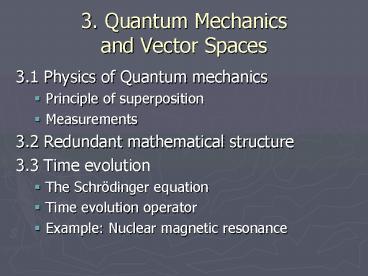3' Quantum Mechanics and Vector Spaces - PowerPoint PPT Presentation
1 / 10
Title:
3' Quantum Mechanics and Vector Spaces
Description:
We can produce interference between different components of a quantum state, e.g. ... self-adjoint ops represent things disallowed by superselection' e.g. real ... – PowerPoint PPT presentation
Number of Views:58
Avg rating:3.0/5.0
Title: 3' Quantum Mechanics and Vector Spaces
1
3. Quantum Mechanics and Vector Spaces
- 3.1 Physics of Quantum mechanics
- Principle of superposition
- Measurements
- 3.2 Redundant mathematical structure
- 3.3 Time evolution
- The Schrödinger equation
- Time evolution operator
- Example Nuclear magnetic resonance
2
3.1.1 Principle of Superposition
- We can produce interference between different
components of a quantum state, e.g. - Two-slit experiment
- photons, electrons, buckyballs (C60)
- Bragg diffraction interference between particles
reflected from different planes in a crystal - Photons, electrons, neutrons, H2 molecules
- Superconducting Quantum Interference Devices
(SQUIDS) interference between electric currents
travelling around loop in opposite directions.
- The most beautiful experiment in physics
- according to Physics World readers (2002)
Credit Tonomura et al, Hitachi Corp.
3
Interference experiments
??
??
SG-x
??
SG z
f
??
??
Feynman thought experiment
- Destructive interference ? genuine wave-like
superposition, not just addition of
probabilities. - Interference pattern depends on both relative
amplitude and phase difference between
components ? represent as complex amplitude. - Interference always seen whenever theory predicts
it should be detectable. - ? Physical states can be added and multiplied by
complex numbers, i.e. they have the structure of
a vector space.
4
Why not stick with wave functions?
- Dont take vector too seriously
- its a metaphor
- Really a general theory of superposables
- So you can always think of waves instead if that
helps. - Often were interested in quantum numbers, not
the wave pattern vector approach avoids
calculating wave functions when not needed. - Wave function picture incomplete
- If you know ?(r) you know everything about
- position, momentum, KE, orbital angular momentum
- but nothing about spin ( other more obscure
quantities) - Vector space allows us to easily include spin.
5
3.1.2 Measurements
- Only certain results found in quantum
measurement - some quantities quantized (ang. mom., atomic
energy levels) - some continuous (position, momentum of a free
particle). - We can prepare quantum states that will
definitely give - any allowed result for a quantized observable
- an arbitrarily small spread for continuous
observables. - ? There is something there to measure.
6
Measurement (continued)
??
SG-z
SG z
Ag
??
- If we superpose definite states of a given
observable, measure the same observable, we
randomly get one of the superposed valuesnever
an intermediate result. - Probability of result a, Prob(a) ? amplitude2
in superposition. - We always get some result ? Probs 1.
7
Mathematical model
- Represent states of definite results
(eigenstates) as a set of orthonormal basis
vectors. - Represent physical states as normalised vectors.
- Probability amplitude for result ai from state ?
ci ?ai ? ?. - zero amplitude to get anything but ai in
definite ai state. - Use projectors instead, if degenerate.
- General state can always be decomposed into a
superposition
8
Mathematical model
- Represent states of definite results
(eigenstates) as a set of orthonormal basis
vectors. - Represent physical states as normalised vectors.
- Probability amplitude for result ai from state ?
ci ?ai ? ?. - zero amplitude to get anything but ai in
definite ai state. - Use projectors instead, if degenerate.
- General state can always be decomposed into a
superposition
- Sum of probabilities 1 is Pythagoras rule in
N-D vector space!
9
3.2 Redundant Mathematical Structure
- A mathematical model for a physical process may
contain things that dont have any physical
meaning. - e.g. in electromagnetism, vector potential is
undetermined up to a gauge change A ? A ?? - Bad thing? May make the maths much easier!
- In QM, physical states are represented by
normalised vectors - Ambiguous up to factor of ei?, i.e. ? ? and
ei?? ? represent the same state. - Normalised vectors do not make a vector
spacemaths requires vectors of all lengths. - Really, physical state equivalent to a ray
through the origin normalisation is a convention
as we could write - Vectors of a particular length phase needed
when analysing a vector into a superposition.
10
Redundancy (continued)
- Hilbert space includes unphysical vectors
- all those with infinite energy, i.e. outside the
domain of the energy operator, H, (e.g.
discontinuous wave functions). - Should other operators (x ? p ?) have finite
expected values? - Perhaps a good reason for ignoring Hilbert space
as such! - Do all possible self-adjoint operators represent
physical observables? - In practice, no we only need a few dozen.
- In theory, no some self-adjoint ops represent
things disallowed by superselection e.g. real
particles are either bosons or fermions, not some
mixture.































